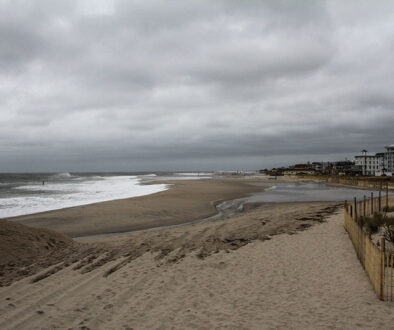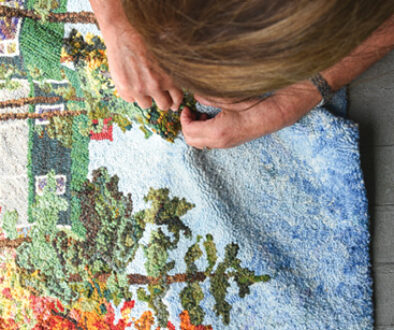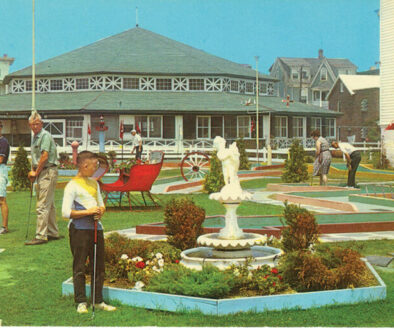In Living Color
The reenactors of Civil War Weekend at Historic Cold Spring Village
The soldiers range in age from barely able to shave to old and grizzled—some even sporting long white beards. You can almost feel the heat coming off them as they stand in a warm September sun, dressed in heavy wool uniforms, awaiting the command of the officers. The younger soldiers appear anxious; this might be their first time. The older soldiers are battled hardened and determined—they’ve been here before. There are onlookers: matrons, nurses and cooks. They have no choice but to wait. A doctor checks his pocket watch.
In the distance the artillery prepares to fire and everything is still until a voice calls out, “Fire!” A cannon blast shakes the ground and a plume of white smoke hangs in the air and again, “Fire!” And then a third.

The woods fill with a sort of haze as the sun shines through the trees and the smoke from the gunpowder drifts across the battlefield. Then, through the trees, there is movement. A wall of men on each side marches slowly towards one another until finally formations are called and the men take aim. Soldiers on both sides wait, and again the order is heard: “Fire!”
This time a volley of muskets from several dozen soldiers ring out and men on both sides fall; a gasp is heard from the audience. A child cries. A man sneezes. A woman takes a picture. “Fire!”
It’s Civil War Weekend at Cold Spring Village, and the afternoon battle is in full swing. Spectators line the battlefield to watch as men and women in authentic period clothes, carrying muskets and manning cannons reenact a battle scene from the American Civil War. Throughout the encampment, you’ll find tents, campfires, aid stations and more, all authentic recreations of a time in the mid-1800’s when America went to war with itself.
Assembled from a collection of 18th and 19th-century buildings, moved from various sites throughout Cape May County to 22 acres of wooded land on Route 9, Cold Spring Village was imagined as a place where visitors could step back in time to a South Jersey rural community of the 1800s—what some call a living history.
But even reenactments have their own history.
In the summer of 1913, just 50 years after the end of the American Civil War, over 57,000 veterans gathered in Gettysburg to honor the 53,000 Americans who died in the great battle, and to commemorate the anniversary of the end of the war. There had been smaller reunions starting as early as 1909, when veterans of Webb’s Brigade met with veterans of Picket’s Division, but nothing of this magnitude.



The encampment, funded by an Act of Congress, was set up in Gettysburg, a sleepy community of just 3,000 at that time, and was overseen by The War Department. Nearly 6,000 tents were pitched, dozens of kitchens erected, 90 latrines dug, and two field hospitals set up. There was even a temporary post office.
What initially was expected to be 40,000 veterans ended up being as many as 57,000, and after 21,000 veterans showed up on the first day when only 6,000 were expected, emergency actions were undertaken, even calling up soldiers from the reserves to active duty to assist. Officers from the state police were on hand to provide security, hundreds of Boy Scouts operated as aides, and the Red Cross assisted with medical care.
Crowds of veterans traveled for days and even weeks, by rail, car and coach, most arriving at stations in Philadelphia and Gettysburg. They came from 45 of the 48 states at the time, and arrived wearing suits and hats, or their old uniforms, and all carrying small suitcases. The average age of the men was 70, with the youngest being 61 and the oldest being 112.
In his subsequent report to Congress, U.S. Army Surgeon A.E. Bradley said, “The camp was unique; surely never before in the world’s history have so great a number of men so advanced in years been assembled under field conditions.”
It was a hot summer and temperatures were reported to be stifling at times, with the interior of at least one tent reaching 103.5 degrees. There were nine reported deaths, perhaps not unexpected given the age of the men and the rough conditions.
Secretary of War Lindley Garrison addressed the crowd, saying, “Once again is Gettysburg the center of the world’s attention. Once again does this field tremble under the tread of a mighty host—not in fear, however, but in joy. The field of enmity has become the field of amity. You have trodden under your feet the bitter weeds of hate and anger, and in their places have sprung up the pure flowers of friendship and love.”
Throughout the encampment, there were reunions and speeches, pictures taken and tales told. On July 3, as part of an official flag ceremony, members of two units, Webb’s Brigade and Picket’s Division, advanced from about 50 feet from one another—the Union from the North, and the Confederate from the South—to flags at the Stone Wall at “Bloody Angle” where they “clasped hands and buried their faces on each other’s shoulders.”
Modern reenactments are thought to have begun during the 1961–1965 Civil War Centennial, with the events growing in popularity during the 1980s and 1990s, due in part because the 125th Anniversary reenactment at Manassas in 1986, attended by more than 6,000 reenactors. The interest inspired a number of films and creative productions such as the movie Glory, a story about the first black regiment to fight in the Civil War, and the extremely popular Ken Burn’s series The Civil War, which debuted in 1990. Three years later, the movie Gettysburg was released. At that time it was reported that there were as many as 50,000 reenactors operating in America.
In many of the movies, thousands of reenactors were used as extras, often wearing their own hand-made uniforms and carrying their own authentic weapons, and often working without pay, even though some had donations made to their organizations to fund future projects. But most of them did it because of their love of history and an unusual hobby.
Reenactors, or “living historians” as they sometimes like to be called, come from all walks of life, from construction workers to lawyers, police officers to college students. A lot of it is generational, as families are often involved and the tradition passed down from generation to generation.
There is definitely a rivalry of sorts among reenactors. Most take their jobs very seriously, often meticulously researching the history of everything from battle formations to uniforms, from the shape of their tent to how their shoes were made. Authenticity is the holy grail, and failure to achieve it can be a point of ridicule among the more devoted. Those who consider it as a game of dress-up and camping are considered FARBs (Far From Being Authentic) and are viewed as either not serious about their craft, or simply lazy.

Most reenactors are considered “mainstream,” and make an effort to be authentic, but may not stay in character the entire time, and might also use some modern items after hours. Progressives, as they prefer to be called, are hard-core enthusiasts, sometimes called “stitch counters” who prefer a total immersive experience, going so far as to eat only seasonal and period-appropriate food and staying in character throughout an event.
Many of the participants will tell you they got into it because of their love of history. In fact, a large percentage of their time is spent making clothing and props by hand, and only a tiny sliver spent reenacting battles. They consider themselves actors, playing a part for audiences, in order to teach them about history. In a typical reenactment, there are encampments that visitors are invited to explore. The participants are there to answer questions, be it about their dress, the customs of the day, or where their regiment fought in the 1860s.
Jim Stephens is the Deputy Director of Cold Spring Village and coordinates Civil War Weekend. He himself was once a union reenactor and understands the work that goes into it.
“We literally couldn’t do it without them,” says Stephens. “Each of these groups dedicates hours of research and preparation. They make their own clothes. They bring their own gear. They travel at their own expense. They’re not paid to do this. And therefore it’s imperative that we treat them with respect and show our appreciation for all the work they do. It’s a partnership.”
According to Stephens, most of the groups that come to HCSV are from within New Jersey, but they also draw from Connecticut, New York, Delaware, Pennsylvania, Maryland, and Virginia. About 200 soldiers on average—with another 50-75 civilians—participate in the event. Many of the brigades have been participating for decades, so organizing the event has become a well-oiled machine.
“The reenactors have their own chain of command, just like in the military,” says Stephens. “So word spreads and everyone knows what they need to do. It’s extremely organized. From set up, to battles, to interacting with the public. The commanders not only inspect uniforms and coordinate battles, they are responsible for safety inspections of the weapons, which are real, and they take that very seriously.”
The main thing visitors will see upon arrival are the encampments, both Union and Confederate, as well as a few civilian ones. They showcase the daily lives of soldiers and civilians at that time, from camp life to the food that soldiers ate. Having been a reenactor himself, Stephens knows how important it is to interact with the guests. They are there to answer questions, so he encourages people to walk through the camps and ask questions.



“This is what presenting history is all about,” says Stephens. “It’s happening right in front of you.”
Joe Donnelly of the Pennsylvania 69th Irish Volunteers was there with his unit, and we noticed a piece of bright green foliage on his cape and asked about the significance of it. “The tradition started with the New York Irish Brigade,” he explained. “Right before the battle of Fredericksburg, their green flag had been torn apart and they were waiting for a new green flag. But they were getting ready to go into the battle, and none of the soldiers wanted to go into battle without their flag. One solider noticed that the only thing growing during the winter there, with the snow and all, was the Boxwood. So they came up with the idea of taking a sprig of Boxwood and putting in their caps, so they could go into battle wearing green.”
It’s this devotion to detail and historical research that separates most reenactors from the so-called “polyester soldiers.”
Reenactor Reginald Wirth of Pennsylvania tells a story about the women who fought, explaining that somewhere between 400 and 600 women fought and served—disguised as men—throughout the war.
Over 20,000 women served in support roles such as cooks and “matrons” including 3,000 middle-class white women who were hired as nurses. Dorothea Dix, the Superintendent of Army nurses, insisted that her nurses be “past 30 years of age, healthy, plain almost to repulsion in dress and devoid of personal attractions.”
One woman, Mary Edwards Walker, having received her medical degree from Syracuse Medical College in New York in 1855, volunteered for Union Army at the outbreak of the war, and served as a surgeon in a field hospital outside Washington, DC. At that time women were not generally considered fit for duty by the Union Army. Since women were not allowed to serve on the battlefield, the ones who did passed themselves off as men. Mary was captured by the Confederate Army after crossing enemy lines to treat wounded civilians, and arrested as a spy. She was later returned as part of a prisoner swap and awarded the Congressional Medal of Honor for bravery. She was one of only eight civilians to have ever received the prestigious honor, and the only woman to have ever done so. It was revoked before her death because she’d never been commissioned, but was reinstated posthumously by President Jimmy Carter in 1977.
Jim Stephens tells the story of Jennie Hodgers, an Irish immigrant living in Illinois who enlisted in the 95th Illinois Infantry under the name Albert Cashier. She was the shortest in the regiment, and largely kept to herself, but was considered “one of the boys.” Her regiment fought as part of the Army of Tennessee and was involved in over 40 engagements throughout the war. Hodgers served a full three-year enlistment and returned to Illinois, where she continued to pass herself off as a man, working a variety of jobs and even voting (women didn’t have the right to vote at this time). It wasn’t until 1910, when she was hit by a car and taken to the hospital that she was discovered, although the local hospital didn’t disclose her true identity. When Hodgers died on October 10, 1915, she was buried in full uniform and her tombstone inscribed with her male identity and military service.
In addition to the events surrounding Civil War Weekend at Cold Spring Village, all of the other buildings are open. Visitors get a sense of what life was like in South Jersey during the first half of the 19th century. There is a print shop, woodworking, pottery studio, blacksmith, basket weaving and a historic inn. These are working shops, making real items, using traditional techniques. A few of the buildings are taken over by the soldiers, just as they would have been during the war at that time. The School House is used as the Confederate headquarters and the Union uses the Tin Shop.
“The centerpiece of each day are the battles,” says Stephens. “Both sides muster at either end of an open wooded area. They use authentic battle formations and tactics, and you get a sense of what it must have been like to see a battle during the Civil War. There are several artillery units and various sizes of cannons and mortars that are fired, and 200 soldiers reenact the type of fight that might have happened in this sort of setting. It’s quite dramatic.”



There is talk within the community that it’s becoming harder to recruit new members, and the ranks are dwindling as the men and women who got involved in the 1980s get older and sleeping on the ground and enduring heavy wool clothes in the heat becomes less of a thrill and more of a burden. It’s a volunteer job, a hobby really, that is not only time intensive but expensive. As of 2011, the estimates had already dropped to 30,000 reenactors and it’s probably even lower today.
“No one could afford to put on an event like this if you didn’t have these men and women sacrificing so much,” says Stephens. “It’s really quite a unique thing.”
There is a real fear that this could be a dying art form and could one day disappear altogether from a combination of an aging community, a lack of interest in American history, and of course the current political environment.
“Reenactors at our event stay away from talking about modern politics,” says Stephens. “If asked, they will change the subject back to the period they are reenacting. They will discuss the flag, specifically the Confederate flag, in historical terms which was more than simply a symbol on the battlefield during the war. Flags played a crucial part in communicating on the battlefield. If you were a soldier trying to stay with your unit, you kept your eye on your battle flag and moved with it. Flags on both sides were used to mark their place on the battlefield. It was considered a great dishonor to lose your colors. Men would fight to the death to keep their colors from being captured. In our environment, flags are critical to presenting an authentic recreation of that time.”
That’s the thing about a living history. It’s always changing. Our understanding and interpretation of events changes over time, but the events stay fixed. It’s been reported that for every day since the end of the Civil War, there has been a book, magazine article or pamphlet written about the war, and it continues to capture the attention of the American psyche. It’s important that we continue to remind ourselves of the horrors of a war between brothers, and remember the 620,000 Americans who died fighting. Veterans on both sides were adamant after the war that their sacrifices not be forgotten and that old wounds heal.
Maybe events such as this will someday be replaced with virtual reality or video games, but for now, you have a unique opportunity to see, hear, touch, taste and smell a piece of history. Walk through a soldier’s camp and speak to a few of its inhabitants, smell the gunpowder and the wood smoke, and hear the thunder of 200 muskets.
Sometimes history springs to life and if you can, it’s good to be there to see it.



